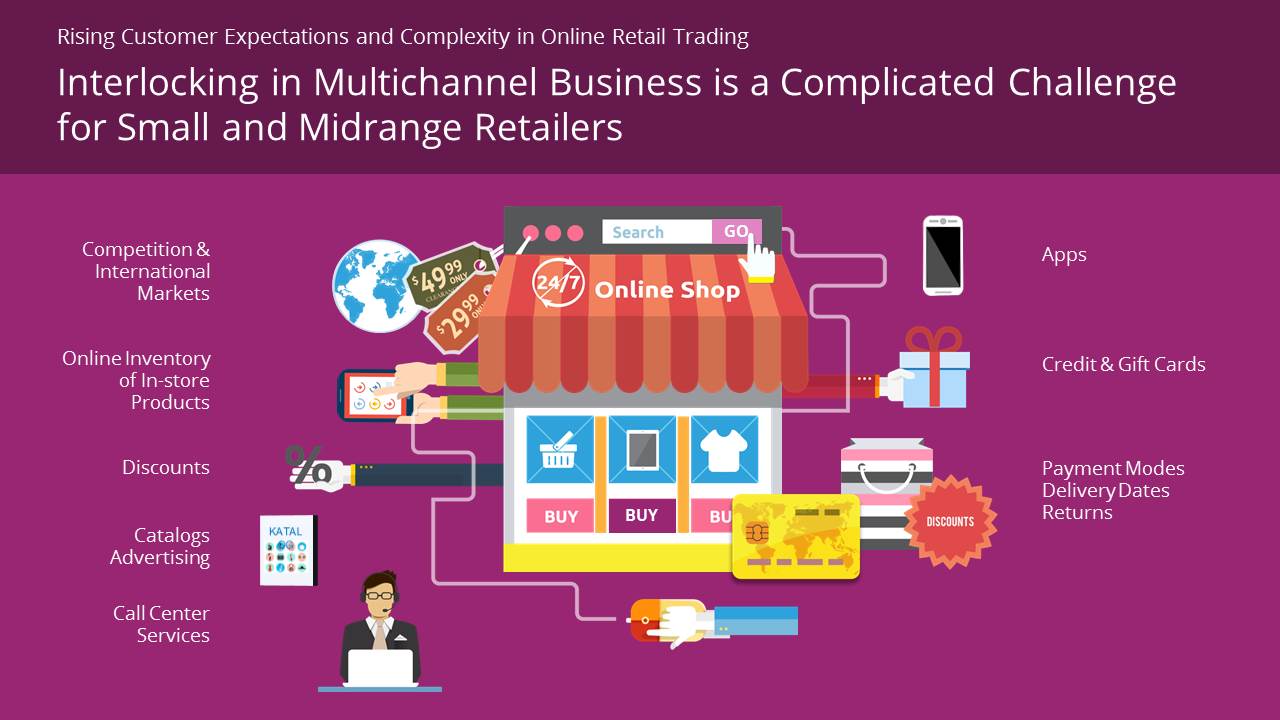How Small and Midrange Businesses Can Survive Between Purely Online Retailers and Large Chains
eCommerce in Germany is going from strength to strength, yet by no means all businesses are benefiting from the trend. Small and midrange retailers in particular are finding it very hard to keep up with the swift pace of online trading requirements.

Small and midrange companies, in contrast, find it hard to gain a foothold in online business. A KfW Research study[3] revealed that in 2015 eCommerce generated just four percent of SMB sales revenues. These figures paint a clear picture. They show that small and midrange companies still have a long way to go on integrating online trading into their business model.
Caught Between Evolved Structures and Swift Competitors with Investors’ Capital
The reasons for this status quo are many and varied. Increasingly exacting customer expectations, for example, make special demands on companies that pursue a multichannel sales strategy. Customers today no longer distinguish between individual channels; they mainly perceive the brand that offers them different touch points. Customers accordingly use the different channels as the fancy takes them and expect them to interlock. So retail store chains should make use of their major advantage over purely online traders – their personal customer contact – to find out which channels customers really want and harmonize them with a view to creating a perfect customer experience. Product ranges should be synchronized, credit and gift vouchers should be redeemable across all channels and goods stocked at branches should be available online.
Ensuring the interlock that customers expect is, however, a major issue for the majority of SMB retailers who take up the challenge of entering the mail order business. They are often originally stationary, fixed location retailers who must first understand the fundamentally different characteristics of mail order and solve basic tasks before setting up digital shop frontends:
- Set up Product Information Management (PIM) technology and processes to create, maintain and distribute relevant product information
Including descriptions, attributes, classifications, images, videos, documents and ratings classic over-the-counter retail does not require because products are there to be seen.
- Expand product range significantly
Mail order has few space restrictions, especially in view of drop shipping models and the like. Active use must be made of the resulting opportunity to list a wider range of products in order to offer the customer added value.
- Develop a suitable warehouse and logistics solution
Using a store network structure only makes sense in test phases or as a complementary unit. Stores’ storage facilities are not designed for delivering products to end customers.
- Implement technology (CRM) and processes to update and utilize customer data
Mail order business models have a major advantage over over-the-counter retail in that there are no anonymous customers. Active use must be made of this advantage to individualize the customer approach. This is where pure chain stores have to make do with customer card systems that are cumbersome and expensive and apart from a few exceptions are used by only a fraction of their customers.
- Establish agile business processes
Over-the-counter retailers still often work with annual plans agreed and released long in advance, with lead times of several months for purchasing and sales campaigns and with largely manually driven processes. Digital sales channels, in contrast, can be controlled and optimized on a daily basis. This also needs to be lived in the minds and processes at the company.
- Integrate new sales channels into the existing corporate landscape
Setting up lighthouse projects or separate sales units can initially help to gain swifter market access and try out different scenarios. In the medium and long term, however, only an integrated approach will help achieve the objective of reducing in-house hostility and getting the entire organization onside.
Furthermore, companies have in some cases spent decades developing structures optimized for use with classical sales channels. There may also be special services that the retailer has offered customers for years and that they have come to expect. With every new sales channel that is to be established, driven by new competitors, customer expectations and growth targets, there are usually significant new and different requirements that cannot be mapped by existing business processes and, above all, systems. As a consequence a hotchpotch of sales channels, responsibilities and isolated commercial and technical solutions quickly takes shape that comes close to the complexity of large enterprises.
This complexity is reflected in what is required of the IT. All specific aspects of the business must be taken into account when a new IT system is to be integrated or the existing system is to be adapted. In spite of this requirement classical retailers from convenience stores to major corporations often lack the technology competence required to assess the consequences of the project accurately. Given the lack of digital DNA among SMBs there is thus a serious risk of neglecting the development of an integrated eCommerce strategy in favor of a one-off lighthouse project.
All too often the maxim is “wash me, but don’t get me wet.”
Furthermore, premature, shortsighted management decisions frequently lead to quick-and-dirty solutions being adopted rather than a long-term corporate strategy. Established Sales departments are also reluctant to relinquish their comfortable evolved structures. The resulting isolated solutions for one increase the complexity and with that the IT input more than is necessary, thereby making systems more vulnerable. For another they satisfy the requirements of only a few stakeholders with the result that the RoI is meager. All too often the maxim is “wash me, but don’t get me wet.” In a world that is characterized by great changes and far-reaching digitization of all business processes this motto is no longer viable and jeopardizes the company’s ability to survive.
High IT Complexity and Low Investment Opportunities
Irrespective of internal corporate deficits SMBs have the following disadvantages compared with externally financed pure players:
- A higher complexity of IT requirements due to the multichannel approach and correspondingly different stakeholder interests
- Legacy liabilities due to a complex, historically evolved IT landscape that hampers new business but keeps existing business going
- IT investments must usually be funded from corporate profits and recoup their costs in the short term, whereas startups can go for growth regardless of return on sales (RoS)
At this point SMB multichannel retailers come up against a decisive disadvantage in competing with big corporations. Unlike the latter, SMBs must, in view of lower sales volumes, fulfill what are often similarly exacting IT requirements by means of much lower investments. For them synergies and economies of scale are far less effective than for their multinational competitors. As a result, SMBs are gradually falling behind competitors with more ample resources.
Comparability Leads to Interchangeability
A further problem is that many SMB retailers offer a limited own-brand product range. In view of the enormous number of providers and comparison opportunities on the Internet they are extremely interchangeable on the World Wide Web. A customer who, say, wants to buy a certain brand of clothing for a new baby will probably either buy from one of the big players she has frequently entrusted with purchases in the past or choose a retailer on the basis of price, delivery date or other services. Only extremely loyal existing customers will actively look for what they want on the retailer’s website. For all other potential customers the aim must be to shout loud and occupy all the relevant touch points on the digital customer journey in order to land in the relevant set – but Google, Facebook and Co. charge hefty prices for fishing in the big pond. So it only pays off for the online retailer if the fish bite on his bait and he can convince the fish to check out what he has to offer in the future. This makes it blatantly obvious that the competitive pressure SMBs face online is enormous.
SMBs have to become niche specialists.
To skirt comparability SMB retailers must occupy a niche that makes them “incomparable” and underscores their distinct identity. The above-mentioned online retailers with a high proportion of third-party brands can reduce this share perceptibly by specifically integrating own brands in their product range. That will not only improve profit margins and make them easier to distinguish from the competition but may also boost customer loyalty and thereby strengthen the corporate brand.
As a niche specialist the company can generate added value to justify higher prices to the customer and go on to extend them. This added value could be an in-depth range and niche knowhow along with special services or a customer loyalty program that is perfectly geared to customers‘ needs. On the basis of this added value a long-term strategy can then be drawn up that defines what is required of an IT solution that has yet to be chosen. Whichever IT strategy is finally adopted its key objective should be the most seamless possible shopping experience for the customer that flexibly interlinks all existing and future sales channels, making shopping simpler for consumers and thereby connecting the advantages of the different worlds – and not the disadvantages.
Make Processes Lean and Avoid Isolated Solutions
To achieve this goal a complex IT system is in many cases not required. Instead, due to the historically evolved (IT) structures of many SMB retailers it can usually be accomplished by making processes leaner. After all, simple, customer-oriented processes take much complexity out of IT projects that can then be completed faster, costing less both to develop and to maintain. The solution might, for example, be to base all sales channels on one PIM, one CRM, one ERP – and thus on a central but strongly modular IT architecture. The single source of truth approach is important in this connection. Data is managed centrally at a single point from which it is supplied to all other systems.
The IT strategy should be seen as a core component of the company.
An important precondition for this kind of process simplification that nevertheless integrates all sales channels is often a change of enterprise processes and culture. For one the IT strategy should be seen not as a one-off project but as a core component of the company itself that connects all other areas efficiently in a data-driven manner. IT systems and processes should therefore be constantly developed further – ideally in an agile way – and adapted to suit changing framework conditions. For another a central challenge that SMBs face is to reduce silo thinking in individual channels that has often taken root over the years and is frequently apparent in the IT landscape as a proliferation of individual isolated solutions. Employees should see a new webshop in the making not as competing with existing sales channels but as an opportunity to lastingly consolidate the IT structure and provide customers with another touch point for the brand.
Conclusion: Life Between Speedboats and Oceangoing Tankers
Companies like Amazon and Zalando that have developed into platform providers and also the many small online pure players with their origins in the World Wide Web have dominated online retail for years and are likely to continue to do so in the years ahead. This status quo is due mainly to a central advantage that these companies enjoy over originally over-the-counter retailers. Backed by ample investment capital, they were able to start from scratch and do not have to do justice to decades of corporate history that have given rise to countless evolved structures. In addition they possess valuable digital knowhow, a modern enterprise culture and agile, lived processes, all of which are important success factors that SMBs especially often lack.
Yet this dilemma is no excuse for burying your head in the sand. The solution, after all, usually lies in making complicated business and IT processes leaner. So the main task for SMBs is to stake out a territory of their own and find a niche in which they can focus on their core business and offer their customers a perceptible added value at an appropriate IT expense. They must make active use of their few advantages over pure players, such as personal customer contact, regional proximity and far-reaching insights into their product range and their regular customers, in order to counteract the mere product-related comparability and in combination with a meaningful multichannel strategy work out a unique selling proposition that convinces the customers. How many retailers will succeed with this high-wire act is, however, anybody’s guess.
[1] http://www.einzelhandel.de/index.php/presse/zahlenfaktengrafiken/item/110185-e-commerce-umsaetze
[2] Arthur D. Little / eco: Die deutsche Internetwirtschaft 2015-2019, 2017: https://www.eco.de/wp-content/blogs.dir/studie_internetwirtschaft_2015-2019.pdf
[3] KfW Research, Dr. Michael Schwartz: E-Commerce steckt im Mittelstand noch in den Kinderschuhen, 2017: https://www.kfw.de/PDF/Download-Center/Konzernthemen/Research/PDF-Dokumente-Fokus-Volkswirtschaft/Fokus-2017/Fokus-Nr.-161-Februar-2017-E-Commerce.pdf
Image source: Fotolia / Syda Productions








